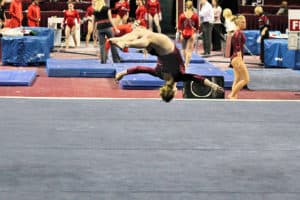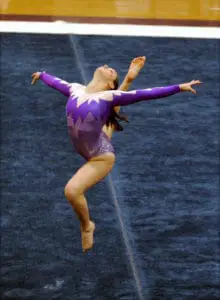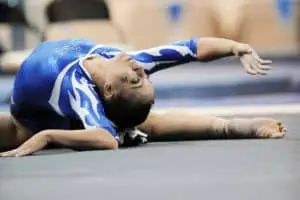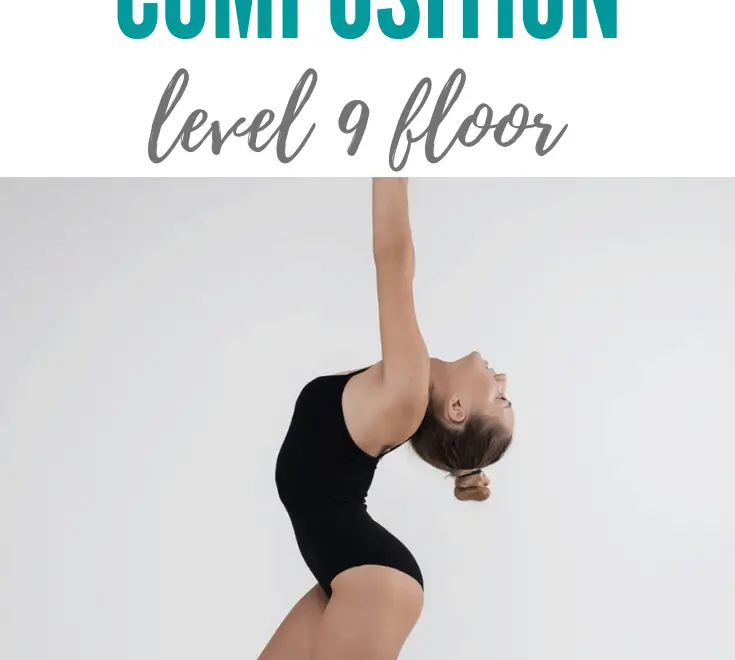This article has been updated to reflect the changes made in the 2022-2026 Code of Points.
Your Level 9 gymnast hits her floor routine. Yes! But the score comes in lower than you both expected. What’s the deal?
At Level 9, there’s a good chance she had some deductions for the composition of the routine. What does that mean? Let’s take a closer look!
This is the second article in a three-part series: Making Sense of Floor Composition. Check out the Level 8 and Level 10 articles too!
In case you missed the first article, this series discusses composition deductions on floor for levels 8, 9, and 10. In 2018, USAG made changes to their composition deductions, in order to make the “up to the level” deductions more specific. There are three categories of “Up to the Level” deductions: Acro, Dance, and Dismount. Today, I will discuss these deductions in detail as they relate to Level 9 floor, with lots of examples.
When a coach and gymnast are constructing a routine, they will first want to consider the skills that are allowable for the gymnast’s level. For those who are unfamiliar, skills in the J.O. Program are valued from A to E, with A skills being the easiest, and E skills being the most difficult. Level 9 gymnasts are allowed to perform any A, B, and C elements, any D/E dance elements, and ONE D/E acro element. D/E elements count as C elements at Level 9 for the purposes of routine construction and bonus.

Acro Composition Deductions
To receive no deduction for acro up to the level, the gymnast must perform “C” saltos in each pass or C, C, B+B direct (3-pass routine), or C+B direct connections in both passes (2-pass routine).
Direct connections are connections of two or more saltos, without any hand support elements in between. An example would be a front layout, front pike.
Indirect connections are connections of two or more saltos with one or more hand support elements in between. An example would be a front tuck stepout, roundoff, back handspring, double full.
Here are some examples:
2-pass routine:
- Pass #1: Back layout 1 ½, front layout (C+B direct, +0.20 bonus)
Pass #2: Front full, front pike (C+B direct, +0.20 bonus)
NO deduction - Pass #1: Front pike stepout, through to back layout 1 ½ (B+C indirect)
Pass #2: Front full, front pike (C+B direct, +0.20 bonus)
0.05 deduction - Pass #1: Double back (D, counts as C for Level 9)
Pass #2: Whip 1/2, front full (B+C direct, +0.20 bonus)
0.10 deduction - Pass #1: Front pike stepout through to back layout double full (B+C indirect)
Pass #2: Back layout 1 1/2, front tuck (C+A direct, +0.10 bonus)
0.10 deduction - Pass #1: Whip, back layout 1 1/2 (A+C direct, +0.10 bonus)
Pass #2: Front full, front tuck (C+A direct, +0.10 bonus)
0.15 deduction - Pass #1: Front full, front tuck (C+A direct, +0.10 bonus)
Pass #2: Back layout double full (C)
0.15 deduction - Pass #1: Front tuck stepout, through to back layout double full (A+C indirect)
Pass #2: Rudi (D, counts as C for Level 9)
0.15 deduction - Pass #1: Front full, front tuck (C+A direct, +0.10 bonus)
Pass #2: Back layout full (B)
0.20 deduction - Pass #1: Back layout full (B)
Pass #2: Front layout, front pike (B+B direct. +0.10 bonus)
0.20 deduction
3-pass routine:
- Pass #1: Back layout double full (C)
Pass #2: Back layout 1 1/2 , front tuck (C+A direct, +0.10 bonus)
Pass #3: Front full (C)
NO deduction - Pass #1: Double back (D, counts as C for Level 9)
Pass #2: Front layout, front layout (B+B, +0.10 bonus)
Pass #3: Back layout 1 1/2 (C)
NO deduction - Pass #1: Back layout double full (C)
Pass #2: Front layout, front tuck (B+A direct)
Pass #3: Front full (C)
0.05 deduction - Pass #1:Front full (C)
Pass #2: Whip ½, front layout (B+B direct, +0.10 bonus)
Pass #3: Front layout, front pike (B+B direct, +0.10 bonus)
0.10 deduction - Pass #1: Front full (C)
Pass #2: Front tuck through to back layout full (A+B indirect)
Pass #3: Back layout 1 ½ (C)
0.10 deduction - Pass #1: Back layout double full (C)
Pass #2: Front layout, front layout (B+B direct, +0.10 bonus)
Pass #3: Back layout full (B)
0.15 deduction - Pass #1: Back layout full (B)
Pass #2: Front layout, front pike (B+B direct)
Pass #3: Front pike (B)
0.2 deduction
The composition for 2-pass routines has been upgraded to require more difficulty this cycle.
Gymnasts will need two C+B directly connected passes for no deduction.
There are still some “gray areas” in Level 9 floor acro – combinations that aren’t specifically listed on the sheet. So here are a few more examples, with a range of possible composition deductions.
2-pass routines:
- Pass #1: Front full (C)
Pass #2: Whip 1/2 , front layout (B+B direct)
0.15-0.20 deduction - Pass #1: Back layout double full (C)
Pass #2: Front layout, front tuck (B+A direct)
Probably 0.20 deduction - Pass #1: Back layout 1 ½, punch front (C+A direct)
Pass #2: Front layout, front layout (B+B direct)
0.10-0.15 deduction

Dance Composition Deductions
To receive no deduction for dance composition, the athlete must perform a minimum of 2 C dance elements. Performing only one B element will incur the maximum 0.2 deduction.
Examples:
- Double turn (C)
Switch-side, straddle jump (C+B)
NO deduction - Switch-ring, sissonne (C+A)
1 ½ turn (B)
0.05 deduction - Switch-side, tuck jump (C+A)
0.10 deduction (gymnast would incur an additional 0.20 deduction for lack of B turn) - Switch leap, tuck jump (B+A)
1 ½ turn (B)
0.15 deduction - Split leap, wolf jump (A+A)
Full turn with leg horizontal (B)
0.20 deduction
As you can see, if the gymnast performs a B turn, which she needs to avoid the compositional deduction for lack of B turn, she is already well on the way to minimizing her dance level deductions. If she can perform a C turn, such as a double turn, she only needs one additional C, either in her dance series or isolated, to fulfill her dance level compositional requirements.

Dismount Composition Deductions
To receive no deduction for the dismount, the gymnast must perform a C salto in her last pass, or a directly connected B+B or better. The maximum dismount level deduction of 0.10 would be incurred if she performs a B+A indirect connection, or an isolated B salto.
Examples:
- Front full (C)
NO deduction - Back layout 1 ½, punch front (C+A)
NO deduction - Front layout, front pike (B+B direct)
NO deduction - Front pike stepout through to back layout full (B+B indirect)
0.05 deduction - Front layout, front tuck (B+A direct)
0.05 deduction - Front tuck stepout through to back layout full (A+B indirect)
0.10 deduction - Front layout (B)
0.10 deduction
Other Composition Deductions
In addition to the “up to the level” deductions, there are a few other compositional deductions that can be applied on Level 9 floor. Here they are:
- Lack of minimum “B” turn: 0.2. If the gymnast attempts a B turn but it is more than 90 degrees incomplete, or if she does not attempt one at all, she will receive this deduction. It doesn’t come off the start value, but instead is taken at the end of the routine.
- Lack of minimum of B salto: 0.3.
- Failure to perform saltos in two different directions: 0.1. The gymnast must perform a backward salto, and a forward or sideward salto. An Arabian salto is considered a forward salto. Aerial cartwheels or walkovers will NOT fulfill this compositional requirement.
- Overuse of dance elements with same shape: 0.1. This deduction would be taken only for more than two straddle jumps (with/without turn), or more than two elements with a wolf or tuck position (with/without turn).
- Insufficient use of floor exercise area: up to 0.1. This deduction could be applied if the gymnast stays in the same section of the floor mat for most of her routine.
And now, it’s time to get to work on constructing those Level 9 routines to minimize deductions and build those scores! What are your favorite skills or combos on Level 9 floor?
References
USA Gymnastics J.O. Code of Points, 2022-2026.
Further Reading
The Ideal Composition for a Level 9 Bar Routine
Making Sense of Composition: Level 8 Beam
Making Sense of Composition: Level 9 Beam
Making Sense of Composition: Level 10 Beam
